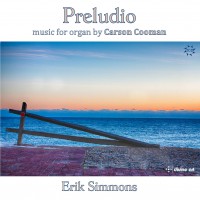Opus 1063
Toccata sequenziale sopra “ut re mi fa” (2014)
for Keyboard
Erik Simmons, organ
Duration: 5 min.
Dedication: for Allan Winkler
 Recorded on Preludio: Music for Organ by Carson Cooman (2016)
Recorded on Preludio: Music for Organ by Carson Cooman (2016)Publisher: Zimbel Press/Subito Music Corp.
Performance materials available from the publisher.
The formal inspiration for this piece came from early Italian keyboard toccatas (those of Frescobaldi are probably the most famous today, though there are certainly many others). However, as with many of my pieces written in the last few years, the early influences do not come exclusively from a single source. The toccatas of Hassler, the ricercari of Steigleder, the fantasias of Cornet and Kerckhoven, the fugues of Couperin, and anonymous late medieval keyboard music all are thrown into the mix, and blended with a contemporary use of mixed modality.
The title refers to the fact that the piece employs sequential chord progressions in numerous places, and that the basic source material is the first four notes of the scale (C–D–E–F), though often inflected into different modes.
The opening section begins with free figuration in the right hand over pedal points in the left hand of the four notes in turn. Four sections follow: each centered on one of the four source pitches. A final coda returns to C.
The music must be performed with complete freedom, in the manner of the early keyboard literature. Understanding of that repertoire is essential to its effective realization.
This toccata may be played on any keyboard instrument. While the harpsichord and organ are most ubiquitous, it could be performed effectively also on clavichord, lautenwerk, harmonium, reed organ, piano, or even electronic keyboard. Dotted ties are intended to be observed on instruments with complete sustain (primarily organs). When performing on the harpsichord, performance most certainly need not be restricted to Italian-style instruments.
Equal temperament is neither expected nor required. (While some chords in the sequential modulations may be somewhat sour in certain meantone temperaments, their use is still possible, at the performer’s discretion.)
